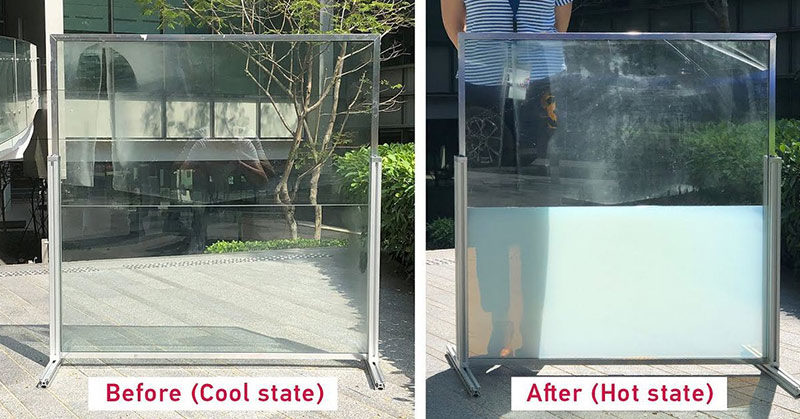Windows and sustainability have not always been synonymous. However, scientists at Nanyang Technological University, Singapore (NTU Singapore) have developed a revolutionary liquid window that reduces sun exposure and energy consumption in buildings.
The Liquid Window That Reduces Energy Consumption
A report by the United Nations in 2009 highlighted that buildings account for 40% of energy usage, with windows contributing to half of that energy consumption.
Traditional glass windows allow easy heat transfer, leading to significant warming in buildings under strong sunlight and heat loss in colder months.
The NTU Singapore liquid window reduces both infrared and visible light, making it a unique energy-saving solution. This liquid-filled glass window adjusts light transmission automatically based on temperature, reducing the need for excessive heating and cooling systems.
The liquid window can decrease heating, ventilation, and air-conditioning usage by up to 45%, resulting in significant cost savings for buildings.
How the Liquid Window Works
The scientists combined micro-hydrogel, a stabilizer, and water to create the unique liquid window. Water’s high specific heat capacity allows it to absorb heat before getting hot itself.
The window turns opaque when heated, blocking sunlight, and returns to a clear state in cooler temperatures. It also releases stored heat into the building, helping to shift energy usage to off-peak times.
“Our innovation combines the unique properties of both types of materials – hydrogel and water. By using a hydrogel-based liquid, we simplify the fabrication process to pouring the mixture between two glass panels. This gives the window a unique advantage of high uniformity, which means the window can be created in any shape and size.” said the lead author of the study, Dr. Long Yi.
Tried and Tested
Outdoor tests in various climates, including Singapore, Guangzhou, and Beijing, demonstrated the efficiency of the liquid window. The Singapore window had a significantly lower temperature compared to traditional windows during the hottest part of the day, while the Beijing window used 11% less energy for temperature control.
In addition to energy savings, the liquid window also reduces noise pollution by 15% more than traditional noise-blocking windows.
“Sound-blocking double glazed windows are made with two pieces of glass separated by an air gap. Our window uses hydrogel-based liquid instead of air, increasing sound insulation between glass panels, offering an additional benefit not commonly found in energy-saving windows.” said study author Wang Shancheng.
Next Steps
The research team is seeking collaboration with industry partners to commercialize the liquid window technology. If successful, this innovation could revolutionize sustainable, energy-efficient, and cost-saving window technology for buildings.
Sources
- https://www.cell.com/joule/fulltext/S2542-4351(20)30403-7?_returnURL=https%3A%2F%2Flinkinghub.elsevier.com%2Fretrieve%2Fpii%2FS2542435120304037%3Fshowall%3Dtrue
- https://media.ntu.edu.sg/NewsReleases/Pages/newsdetail.aspx?news=1e95a8cd-48b2-4ddd-8d96-7bc0013e1c7e






